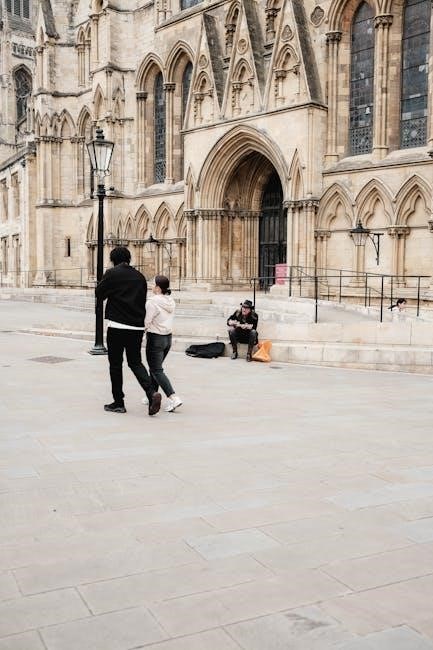A comprehensive guide to understanding coat sizing, ensuring a perfect fit, and effectively using size charts for both men and women to make informed purchasing decisions.
Understanding the Importance of Proper Fit
A proper fit is essential for both comfort and style, ensuring your coat looks great and feels right. Ill-fitting coats can restrict movement or appear unflattering, while a well-tailored coat enhances confidence and sophistication. Accurate measurements are key to achieving this, as they ensure the coat aligns with your body proportions. Whether for everyday wear or special occasions, a coat that fits correctly balances functionality and aesthetics. Understanding the importance of proper fit helps you make informed decisions when shopping, ensuring you find a coat that meets your needs and complements your wardrobe. A good fit is not just about size—it’s about how the coat makes you feel.
- Proper fit ensures comfort and mobility.
- A well-fitting coat enhances your overall appearance.
- Accurate measurements are crucial for the right size.
- A good fit balances style and practicality.
Investing time in finding the perfect fit guarantees long-term satisfaction and a polished look.
How to Use a Coat Size Chart Effectively
Using a coat size chart effectively starts with taking accurate body measurements; Match your chest, waist, and sleeve measurements to the chart to find your ideal size. Remember, size charts may vary between brands, so always refer to the specific guide provided. Consider the tolerance, typically ±1.5 cm, to account for fit preferences. Double-check your measurements and divide by two if the chart uses half-sizes. For the best results, use online size calculators or compare with a well-fitting coat you already own. Understanding how styles differ (e.g., slim-fit vs. oversized) ensures you select the right size for your desired look.
- Take precise measurements before referencing the chart.
- Account for brand-specific sizing variations.
- Use online tools for accurate size matching.
- Consider the coat style when interpreting fit.
This approach ensures a flattering and comfortable fit tailored to your needs.

Essential Measurements for Coat Sizing
Accurate chest, waist, and sleeve measurements are crucial for determining your coat size. Use a flexible tape measure and ensure the tape is level for precise results.
- Chest: Measure around the fullest part of your bust.
- Waist: Measure at your natural waistline.
- Sleeve: Measure from the back of your neck to your wrist.
This ensures a tailored fit and avoids sizing errors.
Chest Measurement: The Key to a Perfect Fit
The chest measurement is the most critical factor in determining your coat size. To measure accurately, wrap a flexible tape measure around the fullest part of your chest, keeping it level and parallel to the floor. For women, this is typically around the bust, while for men, it’s across the broadest part of the chest. Ensure the tape isn’t too tight or loose, as this can skew the measurement. Your chest size directly impacts how the coat fits across the shoulders and torso. Taking this measurement correctly ensures the coat isn’t too restrictive or overly loose, providing both comfort and style. Always double-check your measurement for accuracy to avoid sizing errors.
Waist Measurement: Ensuring Comfort and Style
Measuring your waist is essential for ensuring your coat fits comfortably and stylishly. To measure accurately, locate your natural waistline, typically just above your belly button. Wrap a flexible tape measure around this area, keeping it snug but not overly tight. For women, this measurement is particularly important for tailored coats that nip in at the waist. For men, it helps determine the coat’s midsection fit, avoiding a boxy or overly tight silhouette. A precise waist measurement ensures the coat drapes well and maintains its intended style. This step is crucial for achieving a balanced, flattering fit that aligns with your body proportions.
Sleeve Length: How to Get It Just Right
Accurate sleeve length measurement is key to a coat that looks and feels great. To measure, extend your arm slightly bent at your side, placing the tape measure from the back of your neck, over your shoulder, and down to your wrist. Ensure the tape is snug but not too tight. Proper sleeve length ensures your coat doesn’t restrict movement or appear too short or long. For men, it should cover the shirt cuff, while for women, it should align with the wrist bone. Correct sleeve length balances comfort and style, making it a critical factor in achieving the perfect coat fit.

Interpreting Coat Size Charts
Understanding numeric and alpha sizing systems is essential for selecting the right coat. Match your measurements to the chart to ensure the best fit and comfort.
Understanding Numeric vs. Alpha Sizing
Coat sizes are categorized into numeric and alpha sizing systems. Numeric sizes (e.g., 40, 42) are precise and based on specific measurements, while alpha sizes (S, M, L) are relative and vary by brand. Understanding these differences is crucial for accurate fitting. Numeric sizing often includes a tolerance of about 1.5 cm, allowing for a slight difference between the size listed and the actual garment. To use size charts effectively, match your measurements to the corresponding size, considering whether the brand uses numeric or alpha sizing. Accurate measurements are key to ensuring the best fit, regardless of the sizing system used.
How to Match Your Measurements to the Chart
To ensure a perfect fit, accurately measure your chest, waist, and sleeve length. Compare these measurements to the size chart, noting whether the brand uses numeric or alpha sizing. Numeric sizes (e.g., 40, 42) are precise, while alpha sizes (S, M, L) may vary by brand. Consider the tolerance of 1.5 cm, as sizes can slightly differ. Divide your measurements by 2 for numeric sizing. Use online tools like a jacket size calculator to simplify the process. Always check if the chart is for men’s or women’s coats, as measurements differ. By aligning your measurements with the chart, you can confidently select the right size for a tailored fit.

Men’s Coat Size Guide
A detailed guide for men, offering standard measurements, fit considerations, and tips to determine the ideal coat size, ensuring comfort and style for every body type.
Standard Measurements for Men’s Coats
For men, standard coat measurements focus on chest circumference, sleeve length, and body length. Chest size is the primary factor, measured around the fullest part of the chest. Sleeve length is measured from the center back of the neck to the wrist. Body length varies by coat style, with options like short, regular, or long. Measurements are typically divided into numeric or alpha sizes (S, M, L, XL). Ensuring accurate measurements is crucial for a proper fit. Tolerance, usually ±1.5 cm, may apply. Using a jacket size calculator can help match your measurements to the correct size, ensuring comfort and style.
How to Choose the Right Coat Length
Choosing the right coat length depends on your body type, personal style, and the intended use of the coat. For petite individuals, shorter coats like pea coats or bomber jackets are flattering, as they don’t overwhelm the frame. Taller individuals can opt for longer coats, such as trench coats or overcoats, which create a balanced silhouette. Consider the occasion: formal events may call for longer, more structured coats, while casual outings pair well with shorter, versatile styles. Measure from the base of the neck to the desired hem to ensure the length aligns with your needs. Proper fit and proportion are key for a polished look.

Women’s Coat Size Guide
A women’s coat size guide provides standard measurements and tips for determining your size, ensuring a flattering fit based on body type and personal style preferences.
Standard Measurements for Women’s Coats
For women’s coats, standard measurements focus on chest, waist, and sleeve length. Chest size is measured around the fullest part, ensuring the tape is level and not too tight. Waist measurements are taken at the narrowest point, typically just above the hips. Sleeve length is measured from the center back of the neck to the wrist. These measurements help determine the ideal size, ensuring comfort and style. Body type and coat style can influence fit, with some coats designed to accommodate curves or provide a more relaxed silhouette. Accurate measurements are key to selecting the right size for a flattering and comfortable fit.
How to Determine Your Coat Size
To determine your coat size accurately, start by taking precise body measurements. Use a flexible tape measure to ensure accuracy. Measure your chest at the fullest point, keeping the tape level and not too tight. For the waist, measure at the narrowest point, typically just above the hips. Sleeve length is measured from the center back of the neck, over the shoulder, and down to the wrist with your arm slightly bent. Once you have these measurements, consult a size chart specific to the brand or style you’re interested in, as sizing can vary. Consider the coat’s style—fitted, oversized, or tailored—and the fabric thickness, as these factors can influence fit. If you plan to layer clothing underneath, you may need a larger size. To avoid errors, ensure the tape measure remains level and not constricted. For consistency, take measurements multiple times or have someone assist you. Finally, if uncertain between sizes, consider the desired fit and comfort. Using online size calculators can also provide additional guidance to help you find the perfect fit.

How to Measure Yourself Accurately
Use a flexible tape measure to take precise body measurements. Measure your chest at its fullest point, waist at the narrowest, and sleeves from the neck to wrist. Ensure the tape is level and not too tight for accurate sizing, considering any layers you plan to wear underneath the coat.

Best Practices for Taking Body Measurements
For accurate coat sizing, use a flexible tape measure and stand up straight. Measure your chest at its widest point, keeping the tape level and not too tight. For the waist, measure at the narrowest part of your torso. Sleeve length should be measured from the base of the neck, over the shoulder, and down to the wrist. Ensure the tape measure is parallel to the floor for consistent results. Wear a thin layer of clothing to simulate what you’ll wear under the coat. Take measurements twice for accuracy and consult a size chart to match your measurements to the correct coat size. Avoid twisting or pulling the tape measure taut, as this can lead to incorrect sizing.
Common Mistakes to Avoid
When taking body measurements for a coat, avoid common errors that can lead to poor fit. Not using a flexible tape measure or measuring over bulky clothing can result in inaccurate sizing. Poor posture, such as slouching or leaning, can skew chest and shoulder measurements. Forgetting to keep the tape measure level or allowing it to sag can also cause discrepancies. Additionally, neglecting to measure at the correct points, like the widest part of the chest or the base of the neck for sleeve length, can lead to sizing issues. Always double-check your measurements and ensure the tape is snug but not overly tight for the most accurate results.

Using Online Tools for Size Calculation

Online tools simplify coat sizing by converting your measurements into precise sizes, saving time and reducing fit uncertainties for a seamless shopping experience.
How to Use a Jacket Size Calculator
To use a jacket size calculator, start by gathering your key measurements, such as chest circumference and sleeve length. Enter these details into the calculator, ensuring accuracy for the best results. The tool will process your data and provide a recommended size based on standard sizing charts. Some calculators also allow you to specify preferences, like a slim or relaxed fit. Double-check your measurements to avoid errors, as small discrepancies can affect the outcome. Once you receive your size, compare it with the brand’s specific sizing chart, as variations may exist. This method ensures a tailored fit, saving time and reducing the need for returns.
Benefits of Online Size Guides
Online size guides offer unparalleled convenience and accuracy, helping you find the perfect coat fit without guessing. They eliminate the need for in-store visits, allowing you to shop from home. By entering your measurements, you receive tailored recommendations, reducing the risk of sizing errors. These tools also accommodate diverse body types and styles, ensuring a flattering fit for everyone. Plus, they often include features like size comparisons across brands, minimizing confusion. With 24/7 accessibility, online size guides make shopping efficient and stress-free, saving time and reducing the likelihood of returns. They are a valuable resource for anyone seeking a coat that looks and feels great.

Coat Styles and Fit
Coat styles vary, ensuring a flattering fit for every body type. Accurate measurements and understanding styles help easily choose the perfect coat to ensure comfort and confidence.
Understanding Different Coat Styles
Coat styles vary significantly, catering to different preferences and needs. Trench coats are classic and waterproof, while pea coats offer a tailored, shorter fit. Overcoats are long and structured, designed to layer over suits. Parkas are insulated for extreme cold, often featuring hoods. Ponchos are open, stylish options for casual wear. Each style has unique features, such as lapels, buttons, or belts, impacting the overall look and fit. Understanding these differences helps in selecting a coat that matches your lifestyle and body type, ensuring both functionality and aesthetics. The right style enhances your wardrobe while providing comfort and confidence.
How Coat Style Affects Fit
Coat styles significantly influence fit due to design elements like length, cut, and features. Trench coats and overcoats are longer, requiring accurate sleeve and body measurements for a tailored look. Pea coats, being shorter, emphasize chest and shoulder fit. Parkas, with their bulkier design, prioritize ease of movement and comfort. The fit also depends on details like lapels, belts, or hood styles, which can alter the silhouette. Understanding how each style drapes and fits is crucial for selecting a coat that flatters your body type. Proper measurements ensure the coat complements your frame without compromising comfort or aesthetics, making style and functionality align perfectly.
Ensuring a perfect coat fit involves accurate measurements, understanding size charts, and considering personal style. Use online tools and guides to make informed decisions for a flawless fit every time.
Final Tips for Finding Your Perfect Coat Size
To ensure the best fit, always measure yourself accurately and consult a size chart specific to the brand or style. Consider your body type and personal comfort preferences when choosing a size. Don’t hesitate to use online tools like jacket size calculators for precise sizing. If unsure, sizing up slightly can provide a more comfortable fit. Lastly, read reviews or ask for recommendations to understand how a particular coat runs in sizes. By combining these strategies, you’ll confidently find a coat that fits perfectly and meets your style needs.
